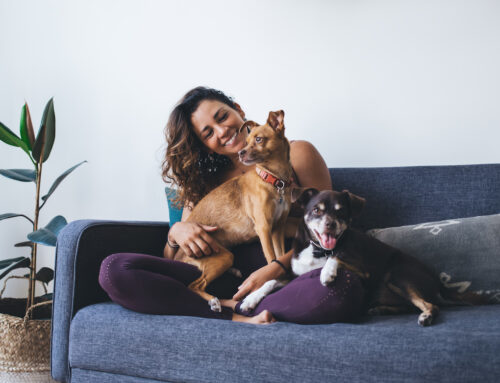Canine parvovirus (also called CPV) is a highly contagious virus for dogs. They can catch it and it can spread very easily. If your dog contracts this virus, he may display a range of concerning symptoms.
Some dogs contract a more serious version of the virus, which can be fatal in some cases. Read on to learn more about the different types of canine parvovirus. We will also show you how you can protect your pup from contracting this deadly disease.
What is Canine Parvovirus?
Parvovirus is a highly contagious and sometimes fatal disease. It mostly affects young dogs between the ages of 6 and 20 weeks. However, dogs of all ages and breeds can catch the virus.
The virus transmits via the stool of an infected dog. However, it can also come from ingesting contaminated food or water. Your pup may also catch it from the environment. In addition to the disease being highly contagious, it is also very resilient and can survive in the environment for months. In the right conditions, canine parvovirus can survive up to 1 year outdoors.
Because this virus is so common and spreads easily, it is often referred to as the “puppy plague.” Most dogs will have vaccines against the disease as young puppies. But even so, they still need to stay away from other dogs to avoid contracting CPV. Since the virus is so contagious, it is also important that you vaccinate your other pets against the disease. Even indoor cats can contract canine parvovirus and are at risk of dying from it.
How Does Your Dog Contract Parvovirus?
The CPV virus has been around since the 1970s, discovered in Europe. The disease is spread through contact with the feces of an infected dog. Keep in mind that it doesn’t have to be a solid stool to spread. It can come from traces of stool on your hands, the floor, etc.
In rare cases, the virus spreads to dogs through the saliva of an infected dog. If your dog has CPV, you will notice symptoms very quickly. This is because the virus multiplies quickly in the dog’s body, causing damage to the cells.
The symptoms of CPV are highly varied, depending on the type of disease your dog contracts.
What are the Symptoms of a Dog with Parvovirus?
The symptoms of canine parvovirus are highly varied and depend on the severity of the infection. Milder cases of CPV result in mild diarrhea and vomiting.
However, in more serious cases, the dog may experience severe symptoms. This includes abdominal pains, lethargy, weight loss and a decreased appetite. If the virus affects the dog’s blood cells, he may also experience bleeding.
This is a general list of canine parvovirus:
- Lethargy
- Loss of appetite
- Weight loss
- Weakness
- Dehydration
- Depression
Keep in mind that observing one or two of these symptoms doesn’t necessarily mean that it’s canine parvo. However, it’s important to get your dog to the veterinarian if you have any concerns or suspicion. This is especially the case if your dog was recently around other dog stools that they may have ingested.
Which Dogs Are Most at Risk For Contracting Parvovirus?
Any dog can contract parvovirus at any age. But puppies and dogs who have never been vaccinated against the disease are most at risk. In fact, puppies under the age of three months old have the greatest risk of dying from CPV.
Older dogs are less likely to contract the disease, but it is important to note that even vaccinated dogs can contract parvovirus. There are many different types of parvovirus. However, vaccines can only protect against the types they were designed to treat.
If your dog has the vaccine but contracts the disease, he may still experience symptoms. This is because the vaccine does not remove the risk of your dog contracting the disease — it only reduces the risk.
Unvaccinated dogs are at much greater risk, although certain breeds are more susceptible than others. Breeds of dogs with a low genetic immunity, such as Doberman Pinchers, Boxers and Bulldogs, are at increased risk of contracting CPV. Unfortunately, this is true even if they have the vaccine.
How Will a Veterinarian Diagnosis Parvo?
If your vet suspects your dog has contracted parvovirus, he’ll likely recommend blood a fecal swab. This is known as Fecal ELISA tests that take about 10 minutes to provide results.
The tests are quite accurate, but a negative result does not mean that your dog is out of the woods. It may be too soon to test and your dog can still have parvo.
If your vet confirms that your dog has parvo, you should quarantine him or her. Quarantine means that your dog cannot to come into contact with other dogs. Keep your dog away from dog parks do not let it visit friends or family if there are dogs there. Quarantine also means keeping your dog away from any unvaccinated puppies up to 6 months old.
Keep in mind that parvo is incredibly contagious. It’s very important that you do not risk infecting other dogs.
How Can You Treat a Dog With Parvovirus?
There is no cure for parvovirus, but there are measures you can take to relieve your dog’s symptoms. The best way to do this is to get proper care from a veterinarian such as Animal Care Center.
We will need to take the following steps to help your dog survive the canine parvovirus:
- Correct his dehydration and electrolyte imbalance
- Administration of fluids that contain electrolytes
- Plasma transfusion may be necessary in severe cases of parvo
- Administration of anti-inflammatory drugs and antibiotics to prevent septicemia
- Drugs are administered to inhibit diarrhea and vomiting
Can Dogs Survive Canine Parvovirus?
Once the virus infests your dog, there is unfortunately no way to kill the virus. Aggressive intervention may save your dog’s life. However, if dogs do not improve within 3 or 4 days, the prognosis is poor.
Final Words: Protect Your Pup Against Parvo
The best way to prevent canine parvovirus is by ensuring that your dog is vaccinated. Vaccination against canine parvovirus is highly recommended for puppies between the ages of 6 and 16 weeks. Your vet will be able to tell you when your puppy was born, so you will know when to schedule the vaccination. In most cases, the parvovirus vaccine comes in two injections spaced a few weeks apart.
Some vets may suggest a third booster shot a year later. If your unvaccinated dog comes into contact with a parvovirus-positive dog, the risk of contracting the disease is high. Therefore, it is wise to have your dog vaccinated as soon as possible.






